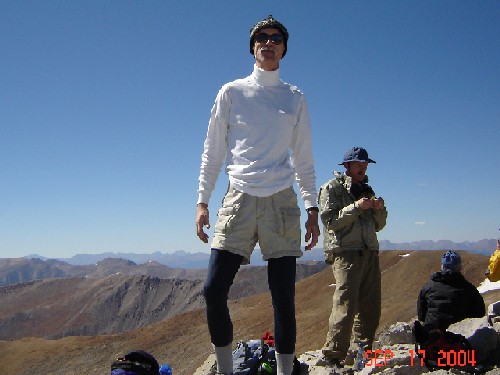
North Maroon Peak
(14,019 ft.)
28 August, 2011: Many climbers consider North Maroon to be Colorado's most difficult fourteener. Virtually all agree that it at least makes the short list. We'd tried it last year and been turned back by rainy weather.
After staying with our friend Miranda in Buena Vista Saturday night, we were up and on the road over Independence Pass long before dawn on Sunday. We rolled into the Maroon Lake parking lot shortly before sunrise. We hit the trail under clear skies, with very mild temperature and virtually no wind.
In less than an hour, we reached the junction where the Maroon-Snowmass trail turns west from the Maroon Creek trail. Scarcely half an hour later, having crossed Minnehaha Creek—and having started the serious climbing—we were shedding garments. We climbed in short sleeves most of the rest of the day.
The standard route on North Maroon consists largely of climbing two adjacent gullies, both of which top out along the mountain's northeast ridge. After that, the route basically flirts with the crest of that ridge, offering amazing views off the north side and finally approaching the summit from the north. The route is actually fairly well cairned, but it's not always easy to see from below. Just as importantly, it is unrelentingly steep, rough, and loose.
Climbing the second gully, we met a group of three who had abandoned their attempt for the summit because it seemed to them that weather was moving in. Respecting their caution, we nevertheless decided to continue up and evaluate conditions as we went.
Perhaps the most difficult route finding on this route comes at the top of the second gully. We finally found a big vertical step which led out onto the top of a large flat rock where we found two small but distinctive cairns leading out onto the ridge crest.
A short climb from this point leads to what is usually regarded as the crux of the route: a small but vertical cliff band which can be breached either by a 4th class crack, or a 3rd class alternative with more exposure, farther out to the right (northwest). We first tried the crack. Trisha went up with me spotting her from below. And that's when we got our first “wake-up call.” Lightning struck.
That's right: We survived a lightning strike. We both felt the electricity through the rock. From the delay before hearing the thunderclap, I estimate that the strike was about a quarter of a mile away—perhaps right on the summit. We got only a diluted bit of the electrical force, but it was still obvious what had happened. We both decided, right then and there, to turn around.
We retreated about 500 vertical feet, to the top of the second gully, and there sat down to eat, drink, rest, clear our minds, and watch the weather. Watching, we were rewarded for our patience. The clouds, thunder, and rain, all seemed to drift on by to the northeast. I could see bits of blue sky and thinning clouds south and west, and I finally suggested that, instead of abandoning all hope, we should start up again, in hopes that a sunny late afternoon would develop.
Showing great courage and determination, Trisha agreed. We forced our already tired muscles to climb onto the ridge and head for the summit once again. Soon, we actually had shadows. Anticipatory exhilaration began to replace the despair of just a few minutes earlier.
A ways up the ridge, we came again to the crux. This time, we passed it by, looking instead for the Class 3 alternative said to exist farther west (climber's right). In just a few minutes, we had found it. As advertised, it offered more exposure than the chimney, but it was indeed Class 3 instead of 4. Also as advertised, when we got on top of it, we noted that it was difficult to make out from above. So, before giving in to the euphoria of finally being able to see the summit block, we marked the location with one of Trisha's famous red mittens, tied to a prominent rock. This saved a lot of uncertainty on the way down.
A short climb over large, broken rocks led to a final saddle, perched in between the summit block and a spectacular promontory to the east (see photos). We finally hauled out on the small summit at about 2:35 MST—over nine hours after leaving the trailhead! (Had it not been for our retreat delay, the ascent time would have been about 6:45. That's still long, but not outrageous.)
The view from the top of this peak is astounding. The amazing symmetry of Maroon Peak grabs one's eye to the south. All the other Elk Range fourteeners can be clearly seen. I was surprised to see that Snowmass Mountain was actually missing most of its namesake snow. We also took in a stunning view of the unnamed peaks and pinnacles to the north—lower than, but every bit as rugged as, the Bells.
Needless to say, we were the last people on the summit that day, so we had it to ourselves. Even though it was getting late, we spent about half an hour there, as the weather was nearly perfect, with virtually no wind. After that, thoroughly pumped from our nearly-missed success, we set off downhill. We made it back to the trailhead in just over four hours—meaning that we still had to get out our headlamps for the last leg!
Photos are at:
https://picasaweb.google.com/tcogwr/NorthMaroonPeak
Long life and many peaks!


0 Comments:
Post a Comment
<< Home